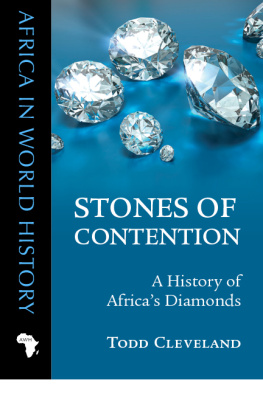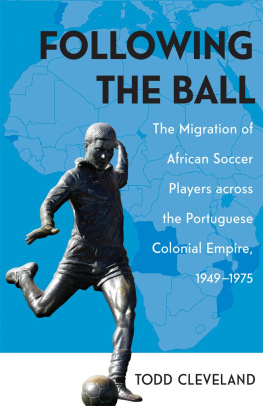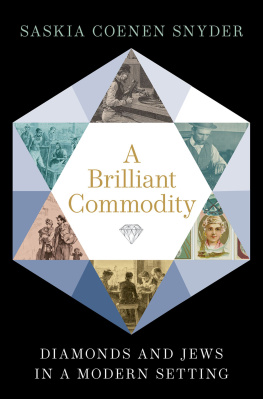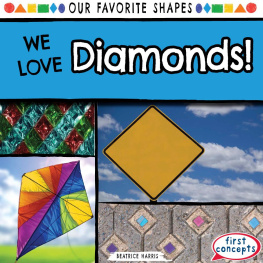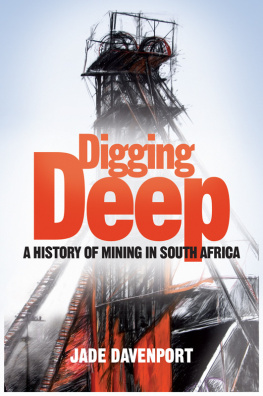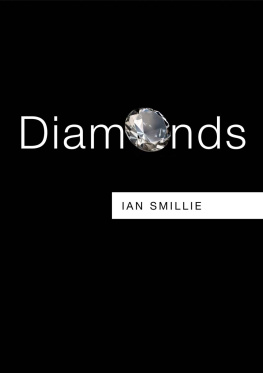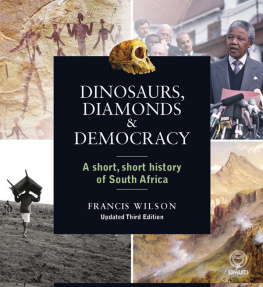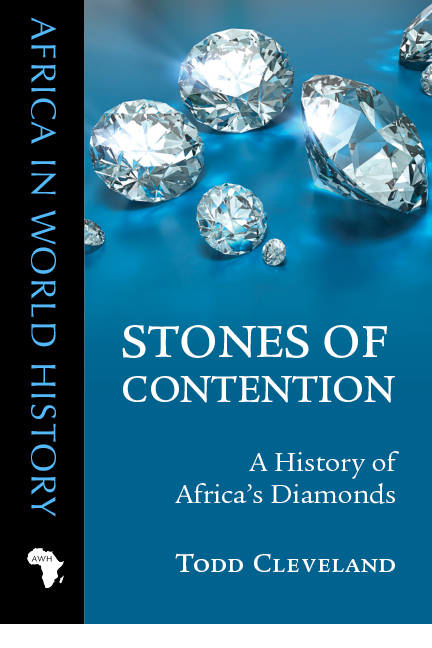Africa in World History
Series editors: David Robinson and Joseph C. Miller
James C. McCann
Stirring the Pot: A History of African Cuisine
Peter Alegi
African Soccerscapes: How a Continent Changed the Worlds Game
Todd Cleveland
Stones of Contention: A History of Africas Diamonds
Forthcoming:
Laura Lee Huttenbach
The Boy Is Gone: Memoirs of a Mau Mau General
John M. Mugane
The Story of Swahili
Charles Ambler
Mass Media and Popular Culture in Modern Africa
Stones of Contention
A History of Africas Diamonds
Todd Cleveland
Ohio University Press
in association with the
Ohio University Center for International Studies
Athens
To Julianna, Lucas, and Byers
Acknowledgments
First and foremost, I would like to thank Gillian Berchowitz, David Robinson, and Joseph Miller. After initially approaching me about this book project, they subsequently provided unwavering support and displayed boundless patience throughout the extended research and writing processes. The concrete forms of their support were myriad, but as this project concludes, I will remember particularly fondly (and miss) Daves steady provision of relevant readings and superb ideas, Gills sage and serene guidance, and Joes timely and innovative suggestions. The uniformly enthusiastic approach of this remarkable editorial team kept this project enjoyable at every turn. Id also like to express my gratitude to the various staff members with whom I interacted at Ohio University Press; to a person, they were consistently helpful and highly professional. At Augustana College, I am grateful for the assistance of the Tredway Library staff, whose members handled my innumerable requests and orders for both on- and off-site materials promptly, always with a smile and often with a welcomed witticism. I would also like to thank former students Bryce Johnson, Anden Drolet, Jaron Gaier and, especially, Sarah Clement for their contributions during the process of compiling the requisite data for the story Ive attempted to tell. Elsewhere, Richard Saunders was extremely helpful, and his writings and insights constituted a much-needed compass as I began to delve into Zimbabwes rapidly shifting diamond mining landscape. Chadia Chambers-Samadi, John Pfautz, and Odino Grubessi provided important assistance as I secured images to incorporate into the text. The inclusion of passages that outline the colonial-era history of diamond mining in Angola was only possible due to the efforts of a great many people on the ground in both Angola and Portugal during my years of fieldwork in those settings. In particular, Id like to thank Drs. Rosa Cruz e Silva, Jorge Varanda, and Nuno Porto, as well as Carl Niemann, and also my many African informants in Angola, whose comprehension of the nature and experience of diamond miningpast and presentwill forever outdistance my own. Im also very grateful to the anonymous readers, whose comments and suggestions were instrumental as I proceeded through the manuscript revision. Finally, this highly edifying and enjoyable endeavor would never have reached fruition had it not been for the relentless support of my wife, Julianna, and the inspirational energy provided by our two sons, Lucas and Byers, the latter of whom joined us in the midst of this project.
Stones of Contention
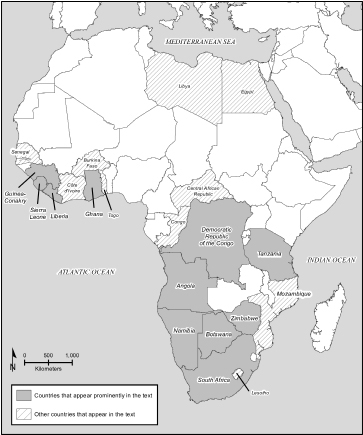
Map 1. Africa. Map by Brian Edward Balsley, GISP
1: An Introduction to Africas Diamonds
In America, it [a diamond] is bling bling. But out here [in Africa] its bling bang.
Danny Archer, Leonardo DiCaprios character in the 2006 film Blood Diamond
Every time you purchase a piece of diamond jewelry there is a real probability that you will be contributing to the provision of schools, clinics, drinking water, or roads for a poor community in Botswana or South Africa or Namibia.
Former Botswana president Festus Mogae, 2008 winner of the Ibrahim Prize, awarded to African heads of state who deliver security, health, education, and economic development to their constituents, and who democratically transfer power to their successors
After a recent talk I gave on the history of diamond production in Angola, an audience member posed the following questions: Have you ever purchased a diamond? And, would you ever purchase an African diamond knowing what you know now? The answer to the first question was easy. Yes, I have purchased a diamond. Before addressing the second question, though, I paused before responding. Actually, I havent had the occasion to buy one since learning what Ive learned. After the audience both moaned and chuckled in response to my equivocation, they prodded me to answer more decidedly. After further deliberation, I finally replied. Yes, I suppose I would.
In the pages that follow, this book strives to enable you to formulate your own informed answers to that audience members second question. Most readers will come to this book with at least some knowledge of the continents diamonds, often gleaned from different forms of popular culture. This output includes Graham Greenes famous novel The Heart of the Matter (1948), and, more recently, both Kanye Wests Grammy-winning single, Diamonds from Sierra Leone (2005), and the blockbuster film Blood Diamond (2006). Other readers will have formed their impressions via the mainstream media, which has highlighted the African origins of many of the diamonds that consumers marvel at behind glass jewelry cases the world over. All of these sources, however, link African diamonds to unbridled chaos and, often, to unimaginable violence. What has been ignored is the much wider range of human experience associated with the extraction of diamonds from Africas soils.
For centuries, Africas diamonds and other minerals have piqued the interest of outsiders and shaped the lives of countless African men, women, and children. This mineral wealth has subjected the continents residents to carnage, exploitation, and widespread suffering. Yet, this wealth has also prompted Africans to pursue creative migration, livelihood, and household strategies; cooperate across potential divides; and acquire technical and managerial skills; and has even facilitated the construction of peaceful, democratic states. In other words, exactly the types of developments that youll never encounter in newspaper headlines or on TV news broadcasts.
This book explores the major developments in the remarkable history of Africas diamonds, from the initial international interest in the continents mineral wealth during the first millennium a.d., down to the present day. This narrative includes the discovery of diamonds in South Africa in 1867, which ushered in an era of unprecedented greed, manifested in exploitative mining operations. Following the ensuing scramble for Africa, during which European powers assumed control of virtually the entire continent, colonial regimes fashioned environments conducive to the commercial objectives of monopolistic diamond enterprises. These companies included, most famously, the industry giant De Beers (explored in detail in chapters 3 and 4). In the aftermath of the birth of independent Africa states, beginning at the end of the 1950s, both rapacious and more responsible regimes joined De Beers and other multinational corporations to oversee mining activity on the continent.
Beyond examinations of these commercial entities, the book also considers the stories of Africans who have been involved with the continents diamonds over the centuries. These individuals include artisanal miners, company mine workers, and the women who support(ed) them; the headmen who often furnished these laborers; armed rebels; mining executives; and premiers of mineral-rich states. Although the industrial literature on diamonds tends to render these individuals anonymous, this text explores the highly varied relationships and experiences that Africans have had with the continents diamonds. By exploring the multiplicity of the human experiences associated with the history of diamond production in Africa, I hope that you will see more than just a glittering accessory the next time you view a diamond in a glass jewelry case. Ultimately, the book aims to help you generate your own answers to the challenging question that the audience member posed to me.

